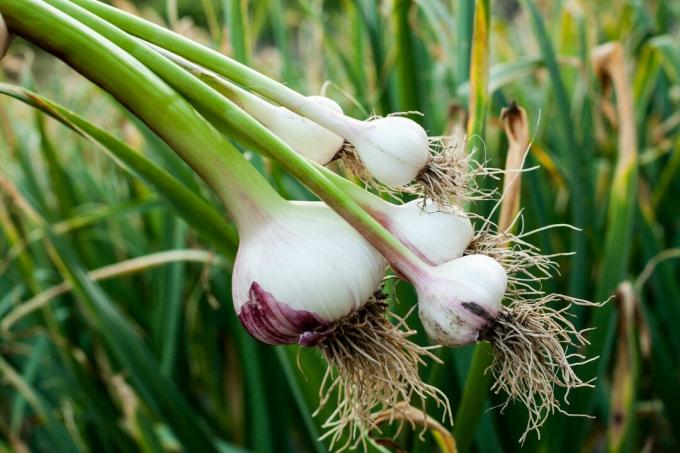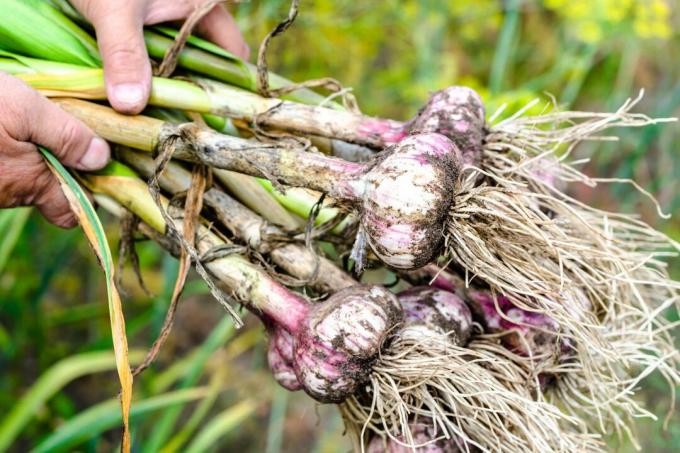Planting garlic in your own garden - with these instructions you can grow it step by step from sticking to harvesting.

It is indispensable in the kitchen and is an absolute must in most countries around the world! Of the garlic (Allium sativum) originally comes from Asia and is very popular as a spice in cooking all over the world. As a relative of Kitchen onion, leek and Co., the "bulb" of garlic is also an onion. In this country, the garlic cloves are mostly imported from other countries, garlic tastes best fresh. In our latitudes, too, the cultivation of the easy-care garlic plants works very well. The following tips will help you plant the garlic successfully in your garden as well.
contents
-
Planting garlic
- The ideal location
- Garlic Types - Regular or Chopped Garlic?
- Poke garlic
- Caring for the garlic plants
- Harvest garlic
- Diseases and pests in garlic
Planting garlic
There are a few things to consider when planting garlic so that it can be grown and a decent harvest can be expected.
The ideal location
Garlic plants are not considered to be particularly demanding, but the correct location should be chosen when setting (in technical terms also sticking) the garlic cloves. For cultivation, the soil should be loose and rich in nutrients, sandy loam soil is ideal. It is very important for the plant that rain and irrigation water can drain away. It is therefore essential to avoid waterlogging. Well-drained soils with a high proportion of sand are therefore well suited for growing garlic. Heavy soils with a high proportion of loam or clay are less suitable. A sunny location should also be selected for optimal growth. Garlic can be grown wonderfully in mixed culture, as it has unwanted pests such as Aphids keep away. Tomatoes are suitable as neighbors, Strawberries and Carrots especially good. However, you must be careful not to have any in close proximity to the garlic plants leek or Onions because these close relatives will be attacked by the same pests. The crop rotation should therefore also be taken into account: Garlic should under no circumstances be planted on the same area as the leek family (Allioideae) grew in the previous year.

These site characteristics are important for garlic cultivation:
- Loose, well-drained and nutrient-rich soil
- No waterlogging (such as B. in very clayey soils)
- Sunny location
- In mixed culture with tomatoes, strawberries, carrots
- Do not plant near leeks or onions
- Not as a post-crop of leek plants
Garlic plants can also be planted in pots without any problems. As a shallow root, a depth of 10cm in the pot is sufficient for successful planting. It is important that the water can drain well. Basically the same conditions apply to this cultivation as in the bed.
Garlic Types - Regular or Chopped Garlic?
When choosing the appropriate Garlic variety First of all, it should be noted that garlic cloves from the supermarket are only suitable for growing in the garden to a limited extent. The reason is as follows: The varieties to be bought there are mostly imported from warmer and sunnier countries. They are therefore not used to our cooler climate in this country and do not grow optimally. Suppliers of seeds or onions therefore have a manageable number of varieties for their own garden. A distinction must be made between normal garlic, in which the cloves are used, and Chives garlic (Allium tuberosum), where the green of the plant is harvested.
Poke garlic
Garlic is a plant that is best pulled from cloves. The garlic cloves can be set twice a year, in spring and autumn. For sticking, the toes are placed at a distance of 15-20 cm at a depth of 3-4 cm. A row spacing of 30 cm is ideal. With the easy-care garlic plant, fertilization is not absolutely necessary. For an improved supply of nutrients, it is still advisable to prepare the soil with green manure and compost before planting. Only cloves of garlic that have already been dried should be used for sticking in order to prevent rot. The use of sprouting toes that are already green on the inside also shortens the cultivation process.
The following tips will help you stick your garlic successfully:
- Stick in spring and / or fall
- Preparation of the soil with green manure and compost
- Distance of 15-20 cm, depth of 3-4 cm, row spacing 30 cm
- Propelled toes ripen faster
Caring for the garlic plants
The garlic plant is basically very easy to care for. The application of fertilizer is not absolutely necessary during the vegetation phase of the plant. Although nitrogen fertilizers increase the yield, the taste is weakened as a result. In order to support the garlic, which grows slowly in the beginning, weeds in the bed should be removed regularly, as they compete with the garlic plant for nutrients. Garlic is also easy to use when it comes to water: it should be watered sparingly, as the aromatic plant is sensitive to overwatering. It should only be poured on very hot days.
Caring for garlic plants is child's play if these points are taken into account:
- No fertilization necessary during growth
- Regular removal of weeds
- Pour little - preferably only on hot days
Harvest garlic
The timing of the Garlic Harvest depends on when the garlic cloves were stuck: When setting the garlic in autumn, you can look forward to the first fresh garlic bulbs as early as July. When planting out in the spring, ripening takes a few weeks longer, so that the harvest time is from August until autumn. It is advisable to harvest the garlic as soon as the top third of the plant begins to wither. For harvesting, the whole plant is pulled out of the earth. Care should be taken not to damage the tuber, as this will reduce the shelf life.
In dry weather, the freshly harvested garlic can dry on the bed. To store the garlic, it is advisable to braid the green of the plant and hang it together with the tuber in a well-ventilated and dry place. The longest way to store garlic is in a dark and cool place. A small note: It should not be kept in the refrigerator, as it loses its aroma after a few days! As an alternative, garlic can also be soaked in oil to preserve the aroma.

Diseases and pests in garlic
Garlic cannot exactly be called disease-prone - on the contrary, it drives away its smell pests like aphids, making it the perfect neighbor in a mixed culture power. In rare cases, the otherwise robust garlic can still be attacked by onion flies. The larvae of the animals are a typical pest in bulbous plants. The flies lay their eggs in the garlic plant in May, and the larvae then eat their way through the plant. Culture protection nets, through whose tight meshes the flies cannot get through, offer reliable protection. If the pests still occur, it is recommended, for example Organic vegetable grit apply to increase the resilience of the plant. Further problems can occur in very rainy summers or in waterlogged conditions. These conditions increase the likelihood of root rot and fungal infections. Affected plants should be removed from the bed. As a rule, however, problems rarely arise with garlic and cultivation is very easy.
Garlic is well known and loved, but you already know that one Chives garlic? We will introduce you to chives and explain everything you need to know about cultivation, care and co.
Many thanks to Floragard for their support!

